Strategic Evaluation of Hotel Expansion into Emerging Markets
VerifiedAdded on 2023/06/08
|32
|6828
|281
Project
AI Summary
This project provides a comprehensive analysis of a hotel's strategic growth options in an emerging market, focusing on Marriott International's potential expansion into New Zealand. It includes a SWOT analysis of Marriott, evaluating its strengths, weaknesses, opportunities, and threats. The project also features a PEST analysis of New Zealand, examining political, economic, social, and technological factors relevant to the hospitality industry. Furthermore, it discusses market segmentation strategies, the application of Porter's Five Forces, and various market growth strategies like the Ansoff Matrix and Nykiels strategy matrix. The study concludes with recommendations for implementing a successful market entry strategy, emphasizing the importance of adapting to local conditions and leveraging crowd sourcing to enhance personalization and customer satisfaction.
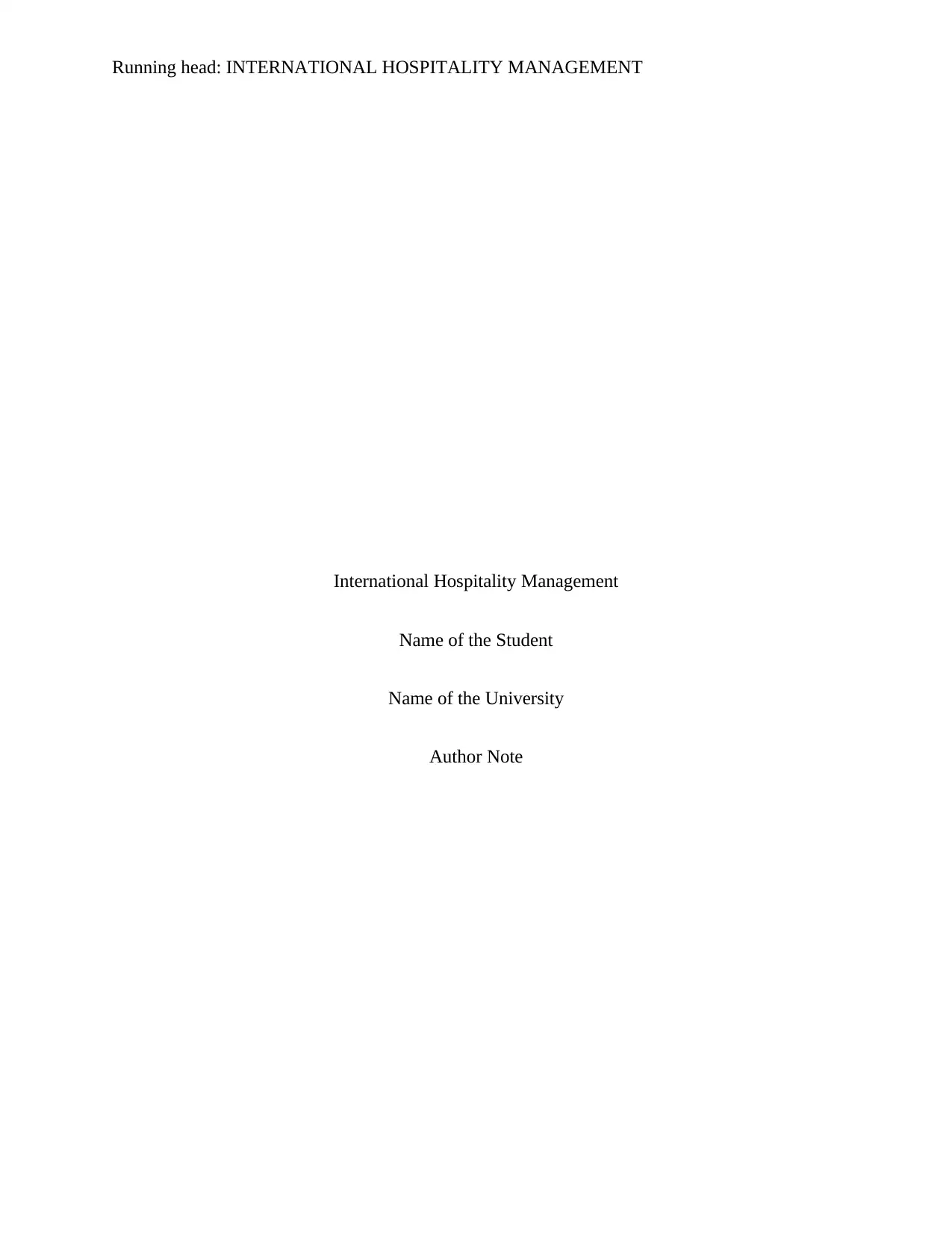
Running head: INTERNATIONAL HOSPITALITY MANAGEMENT
International Hospitality Management
Name of the Student
Name of the University
Author Note
International Hospitality Management
Name of the Student
Name of the University
Author Note
Paraphrase This Document
Need a fresh take? Get an instant paraphrase of this document with our AI Paraphraser
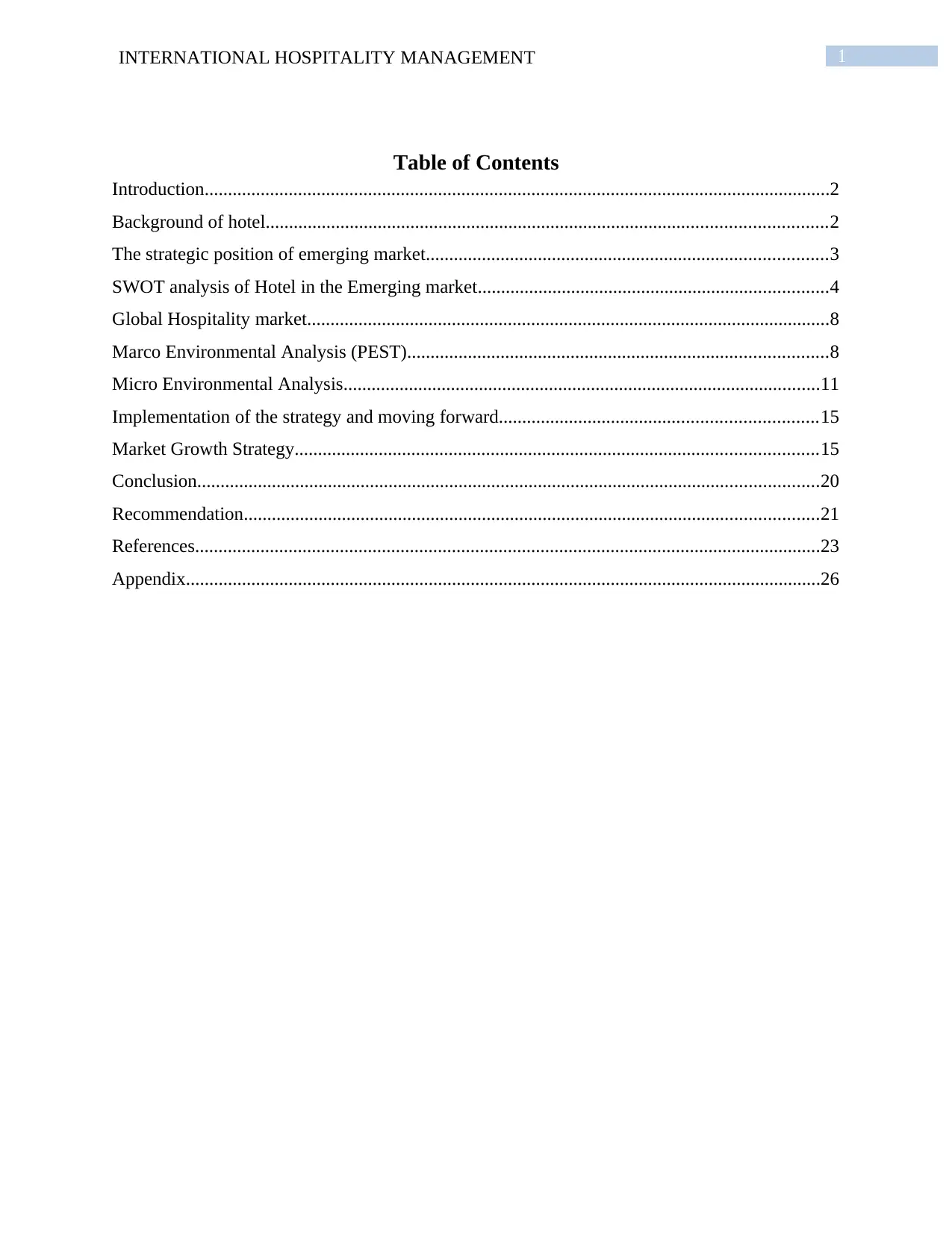
1INTERNATIONAL HOSPITALITY MANAGEMENT
Table of Contents
Introduction......................................................................................................................................2
Background of hotel........................................................................................................................2
The strategic position of emerging market......................................................................................3
SWOT analysis of Hotel in the Emerging market...........................................................................4
Global Hospitality market................................................................................................................8
Marco Environmental Analysis (PEST)..........................................................................................8
Micro Environmental Analysis......................................................................................................11
Implementation of the strategy and moving forward....................................................................15
Market Growth Strategy................................................................................................................15
Conclusion.....................................................................................................................................20
Recommendation...........................................................................................................................21
References......................................................................................................................................23
Appendix........................................................................................................................................26
Table of Contents
Introduction......................................................................................................................................2
Background of hotel........................................................................................................................2
The strategic position of emerging market......................................................................................3
SWOT analysis of Hotel in the Emerging market...........................................................................4
Global Hospitality market................................................................................................................8
Marco Environmental Analysis (PEST)..........................................................................................8
Micro Environmental Analysis......................................................................................................11
Implementation of the strategy and moving forward....................................................................15
Market Growth Strategy................................................................................................................15
Conclusion.....................................................................................................................................20
Recommendation...........................................................................................................................21
References......................................................................................................................................23
Appendix........................................................................................................................................26
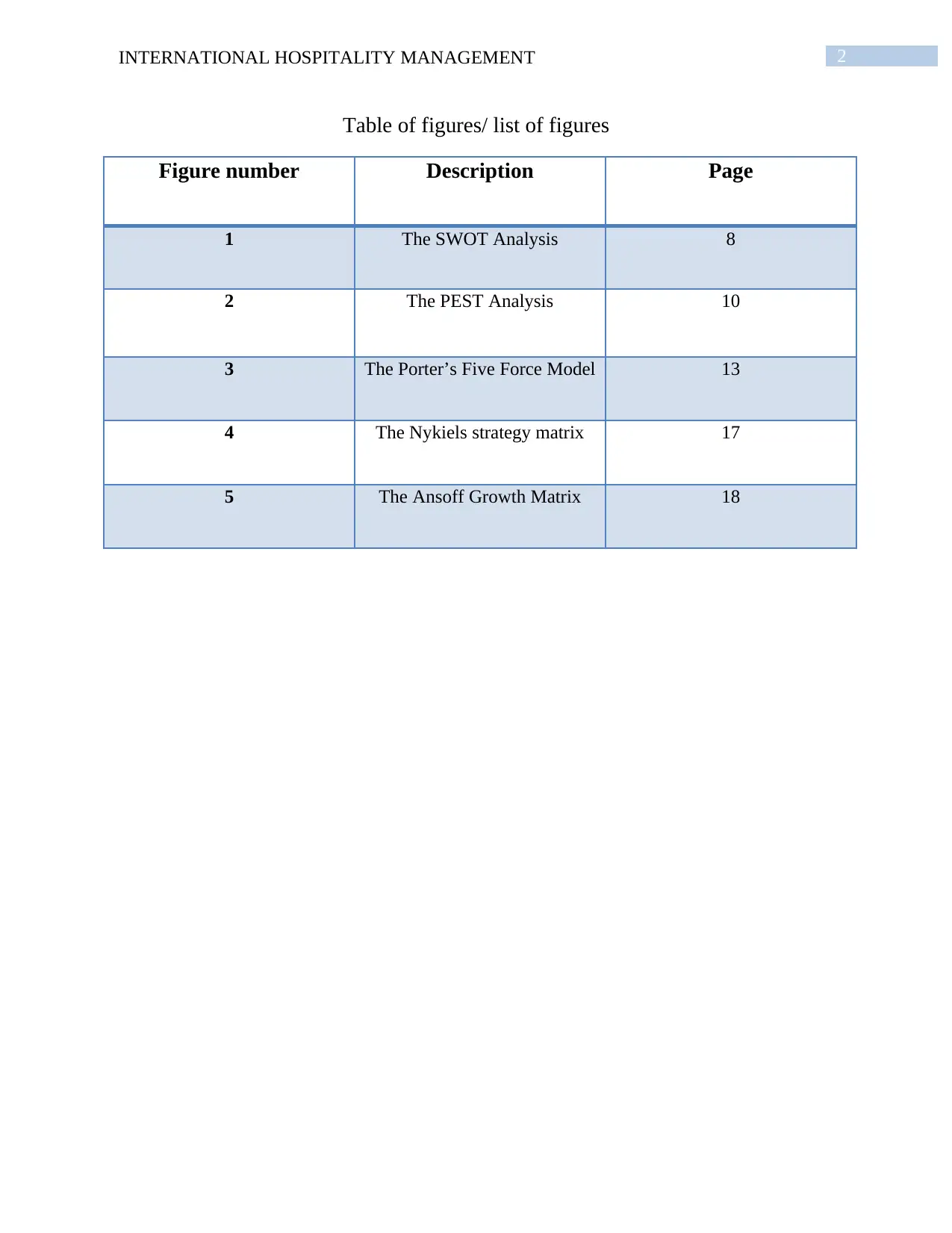
2INTERNATIONAL HOSPITALITY MANAGEMENT
Table of figures/ list of figures
Figure number Description Page
1 The SWOT Analysis 8
2 The PEST Analysis 10
3 The Porter’s Five Force Model 13
4 The Nykiels strategy matrix 17
5 The Ansoff Growth Matrix 18
Table of figures/ list of figures
Figure number Description Page
1 The SWOT Analysis 8
2 The PEST Analysis 10
3 The Porter’s Five Force Model 13
4 The Nykiels strategy matrix 17
5 The Ansoff Growth Matrix 18
⊘ This is a preview!⊘
Do you want full access?
Subscribe today to unlock all pages.

Trusted by 1+ million students worldwide
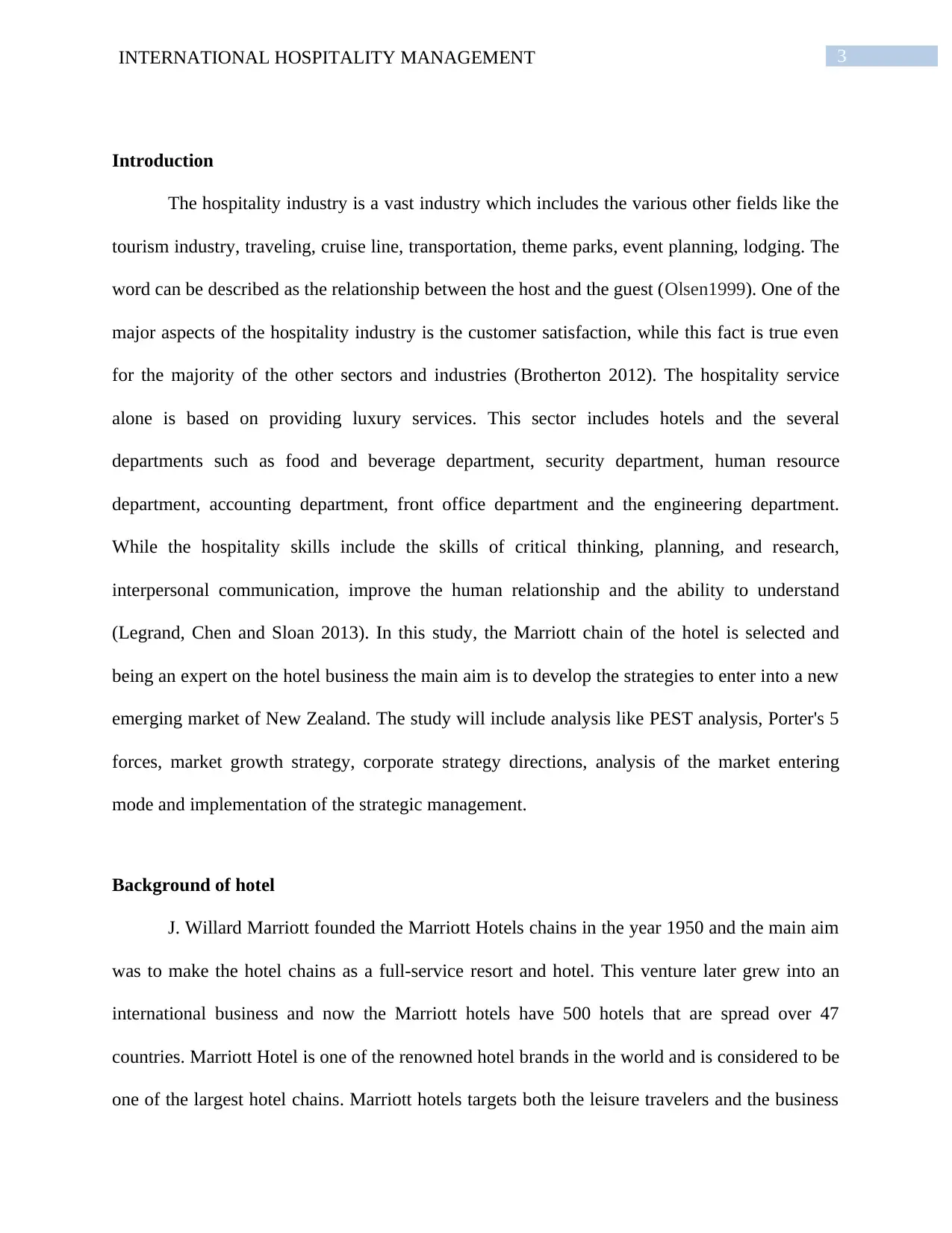
3INTERNATIONAL HOSPITALITY MANAGEMENT
Introduction
The hospitality industry is a vast industry which includes the various other fields like the
tourism industry, traveling, cruise line, transportation, theme parks, event planning, lodging. The
word can be described as the relationship between the host and the guest (Olsen1999). One of the
major aspects of the hospitality industry is the customer satisfaction, while this fact is true even
for the majority of the other sectors and industries (Brotherton 2012). The hospitality service
alone is based on providing luxury services. This sector includes hotels and the several
departments such as food and beverage department, security department, human resource
department, accounting department, front office department and the engineering department.
While the hospitality skills include the skills of critical thinking, planning, and research,
interpersonal communication, improve the human relationship and the ability to understand
(Legrand, Chen and Sloan 2013). In this study, the Marriott chain of the hotel is selected and
being an expert on the hotel business the main aim is to develop the strategies to enter into a new
emerging market of New Zealand. The study will include analysis like PEST analysis, Porter's 5
forces, market growth strategy, corporate strategy directions, analysis of the market entering
mode and implementation of the strategic management.
Background of hotel
J. Willard Marriott founded the Marriott Hotels chains in the year 1950 and the main aim
was to make the hotel chains as a full-service resort and hotel. This venture later grew into an
international business and now the Marriott hotels have 500 hotels that are spread over 47
countries. Marriott Hotel is one of the renowned hotel brands in the world and is considered to be
one of the largest hotel chains. Marriott hotels targets both the leisure travelers and the business
Introduction
The hospitality industry is a vast industry which includes the various other fields like the
tourism industry, traveling, cruise line, transportation, theme parks, event planning, lodging. The
word can be described as the relationship between the host and the guest (Olsen1999). One of the
major aspects of the hospitality industry is the customer satisfaction, while this fact is true even
for the majority of the other sectors and industries (Brotherton 2012). The hospitality service
alone is based on providing luxury services. This sector includes hotels and the several
departments such as food and beverage department, security department, human resource
department, accounting department, front office department and the engineering department.
While the hospitality skills include the skills of critical thinking, planning, and research,
interpersonal communication, improve the human relationship and the ability to understand
(Legrand, Chen and Sloan 2013). In this study, the Marriott chain of the hotel is selected and
being an expert on the hotel business the main aim is to develop the strategies to enter into a new
emerging market of New Zealand. The study will include analysis like PEST analysis, Porter's 5
forces, market growth strategy, corporate strategy directions, analysis of the market entering
mode and implementation of the strategic management.
Background of hotel
J. Willard Marriott founded the Marriott Hotels chains in the year 1950 and the main aim
was to make the hotel chains as a full-service resort and hotel. This venture later grew into an
international business and now the Marriott hotels have 500 hotels that are spread over 47
countries. Marriott Hotel is one of the renowned hotel brands in the world and is considered to be
one of the largest hotel chains. Marriott hotels targets both the leisure travelers and the business
Paraphrase This Document
Need a fresh take? Get an instant paraphrase of this document with our AI Paraphraser
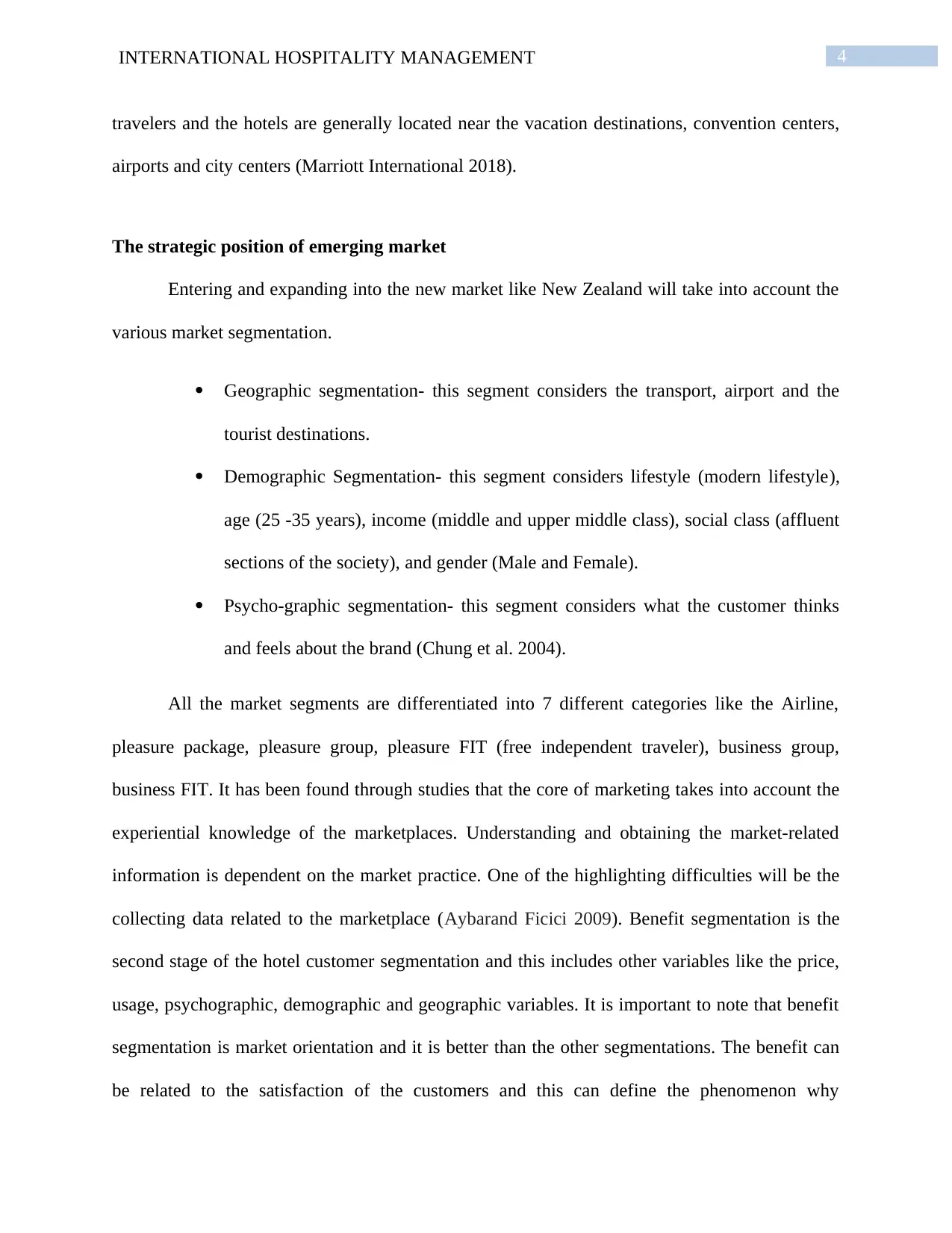
4INTERNATIONAL HOSPITALITY MANAGEMENT
travelers and the hotels are generally located near the vacation destinations, convention centers,
airports and city centers (Marriott International 2018).
The strategic position of emerging market
Entering and expanding into the new market like New Zealand will take into account the
various market segmentation.
Geographic segmentation- this segment considers the transport, airport and the
tourist destinations.
Demographic Segmentation- this segment considers lifestyle (modern lifestyle),
age (25 -35 years), income (middle and upper middle class), social class (affluent
sections of the society), and gender (Male and Female).
Psycho-graphic segmentation- this segment considers what the customer thinks
and feels about the brand (Chung et al. 2004).
All the market segments are differentiated into 7 different categories like the Airline,
pleasure package, pleasure group, pleasure FIT (free independent traveler), business group,
business FIT. It has been found through studies that the core of marketing takes into account the
experiential knowledge of the marketplaces. Understanding and obtaining the market-related
information is dependent on the market practice. One of the highlighting difficulties will be the
collecting data related to the marketplace (Aybarand Ficici 2009). Benefit segmentation is the
second stage of the hotel customer segmentation and this includes other variables like the price,
usage, psychographic, demographic and geographic variables. It is important to note that benefit
segmentation is market orientation and it is better than the other segmentations. The benefit can
be related to the satisfaction of the customers and this can define the phenomenon why
travelers and the hotels are generally located near the vacation destinations, convention centers,
airports and city centers (Marriott International 2018).
The strategic position of emerging market
Entering and expanding into the new market like New Zealand will take into account the
various market segmentation.
Geographic segmentation- this segment considers the transport, airport and the
tourist destinations.
Demographic Segmentation- this segment considers lifestyle (modern lifestyle),
age (25 -35 years), income (middle and upper middle class), social class (affluent
sections of the society), and gender (Male and Female).
Psycho-graphic segmentation- this segment considers what the customer thinks
and feels about the brand (Chung et al. 2004).
All the market segments are differentiated into 7 different categories like the Airline,
pleasure package, pleasure group, pleasure FIT (free independent traveler), business group,
business FIT. It has been found through studies that the core of marketing takes into account the
experiential knowledge of the marketplaces. Understanding and obtaining the market-related
information is dependent on the market practice. One of the highlighting difficulties will be the
collecting data related to the marketplace (Aybarand Ficici 2009). Benefit segmentation is the
second stage of the hotel customer segmentation and this includes other variables like the price,
usage, psychographic, demographic and geographic variables. It is important to note that benefit
segmentation is market orientation and it is better than the other segmentations. The benefit can
be related to the satisfaction of the customers and this can define the phenomenon why
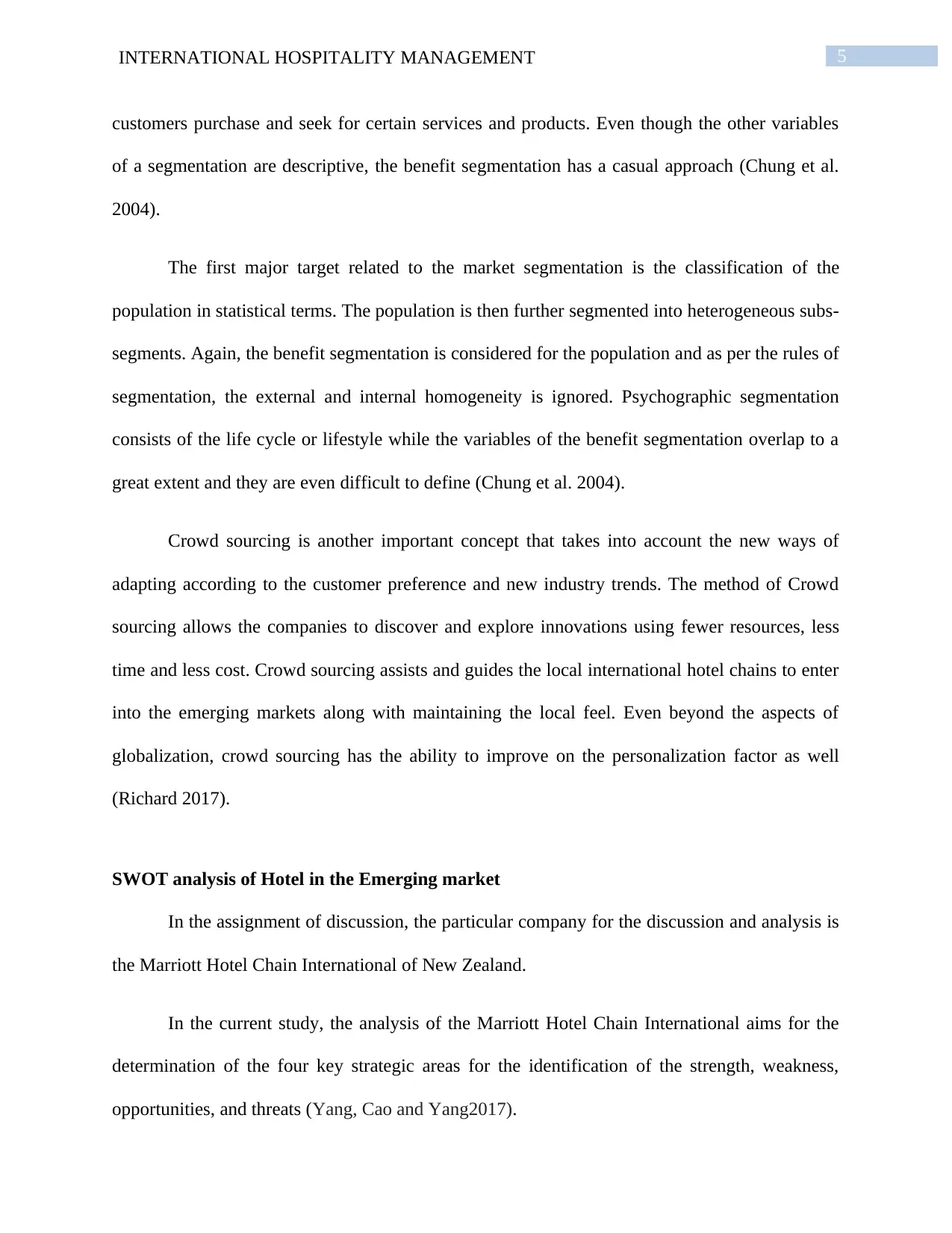
5INTERNATIONAL HOSPITALITY MANAGEMENT
customers purchase and seek for certain services and products. Even though the other variables
of a segmentation are descriptive, the benefit segmentation has a casual approach (Chung et al.
2004).
The first major target related to the market segmentation is the classification of the
population in statistical terms. The population is then further segmented into heterogeneous subs-
segments. Again, the benefit segmentation is considered for the population and as per the rules of
segmentation, the external and internal homogeneity is ignored. Psychographic segmentation
consists of the life cycle or lifestyle while the variables of the benefit segmentation overlap to a
great extent and they are even difficult to define (Chung et al. 2004).
Crowd sourcing is another important concept that takes into account the new ways of
adapting according to the customer preference and new industry trends. The method of Crowd
sourcing allows the companies to discover and explore innovations using fewer resources, less
time and less cost. Crowd sourcing assists and guides the local international hotel chains to enter
into the emerging markets along with maintaining the local feel. Even beyond the aspects of
globalization, crowd sourcing has the ability to improve on the personalization factor as well
(Richard 2017).
SWOT analysis of Hotel in the Emerging market
In the assignment of discussion, the particular company for the discussion and analysis is
the Marriott Hotel Chain International of New Zealand.
In the current study, the analysis of the Marriott Hotel Chain International aims for the
determination of the four key strategic areas for the identification of the strength, weakness,
opportunities, and threats (Yang, Cao and Yang2017).
customers purchase and seek for certain services and products. Even though the other variables
of a segmentation are descriptive, the benefit segmentation has a casual approach (Chung et al.
2004).
The first major target related to the market segmentation is the classification of the
population in statistical terms. The population is then further segmented into heterogeneous subs-
segments. Again, the benefit segmentation is considered for the population and as per the rules of
segmentation, the external and internal homogeneity is ignored. Psychographic segmentation
consists of the life cycle or lifestyle while the variables of the benefit segmentation overlap to a
great extent and they are even difficult to define (Chung et al. 2004).
Crowd sourcing is another important concept that takes into account the new ways of
adapting according to the customer preference and new industry trends. The method of Crowd
sourcing allows the companies to discover and explore innovations using fewer resources, less
time and less cost. Crowd sourcing assists and guides the local international hotel chains to enter
into the emerging markets along with maintaining the local feel. Even beyond the aspects of
globalization, crowd sourcing has the ability to improve on the personalization factor as well
(Richard 2017).
SWOT analysis of Hotel in the Emerging market
In the assignment of discussion, the particular company for the discussion and analysis is
the Marriott Hotel Chain International of New Zealand.
In the current study, the analysis of the Marriott Hotel Chain International aims for the
determination of the four key strategic areas for the identification of the strength, weakness,
opportunities, and threats (Yang, Cao and Yang2017).
⊘ This is a preview!⊘
Do you want full access?
Subscribe today to unlock all pages.

Trusted by 1+ million students worldwide
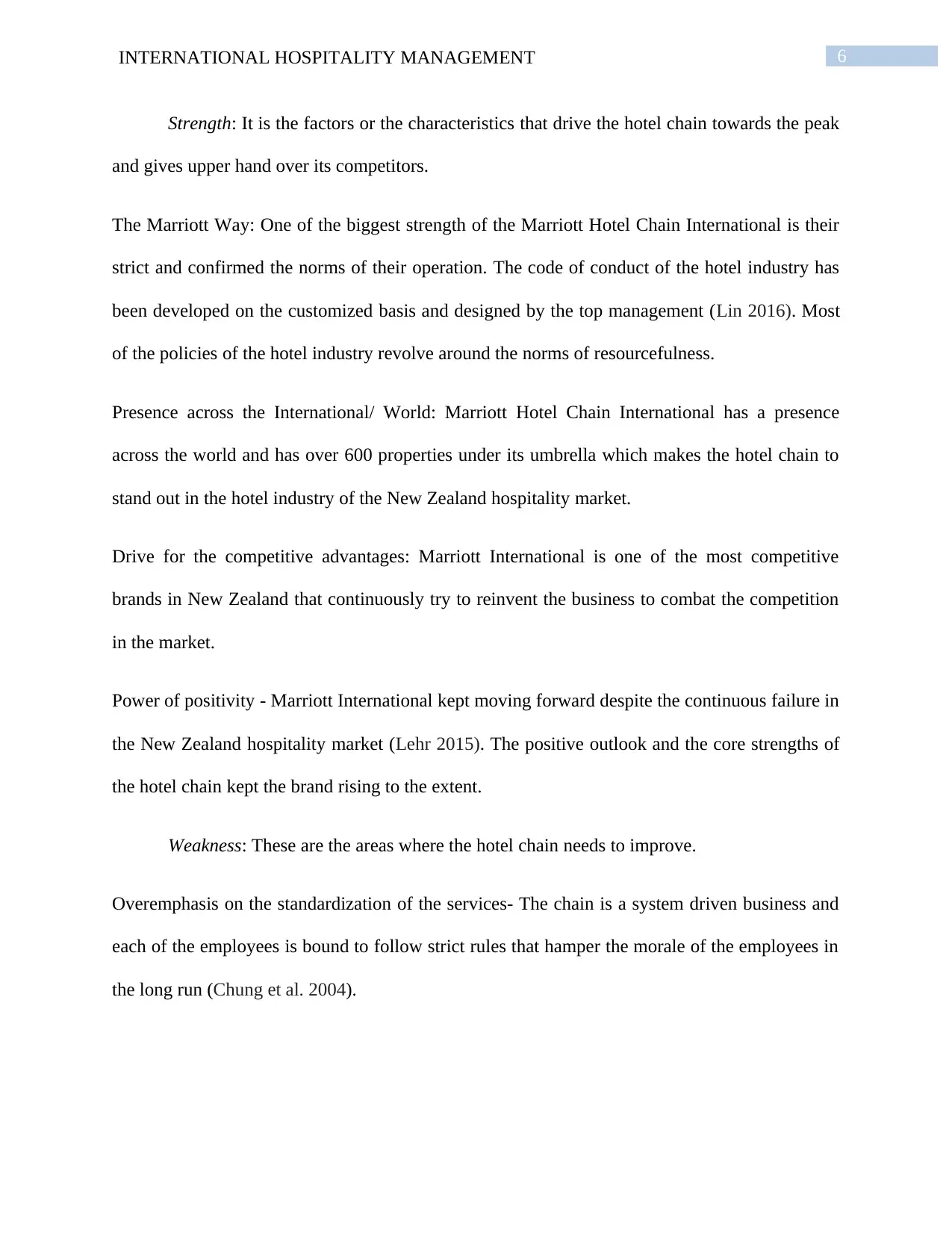
6INTERNATIONAL HOSPITALITY MANAGEMENT
Strength: It is the factors or the characteristics that drive the hotel chain towards the peak
and gives upper hand over its competitors.
The Marriott Way: One of the biggest strength of the Marriott Hotel Chain International is their
strict and confirmed the norms of their operation. The code of conduct of the hotel industry has
been developed on the customized basis and designed by the top management (Lin 2016). Most
of the policies of the hotel industry revolve around the norms of resourcefulness.
Presence across the International/ World: Marriott Hotel Chain International has a presence
across the world and has over 600 properties under its umbrella which makes the hotel chain to
stand out in the hotel industry of the New Zealand hospitality market.
Drive for the competitive advantages: Marriott International is one of the most competitive
brands in New Zealand that continuously try to reinvent the business to combat the competition
in the market.
Power of positivity - Marriott International kept moving forward despite the continuous failure in
the New Zealand hospitality market (Lehr 2015). The positive outlook and the core strengths of
the hotel chain kept the brand rising to the extent.
Weakness: These are the areas where the hotel chain needs to improve.
Overemphasis on the standardization of the services- The chain is a system driven business and
each of the employees is bound to follow strict rules that hamper the morale of the employees in
the long run (Chung et al. 2004).
Strength: It is the factors or the characteristics that drive the hotel chain towards the peak
and gives upper hand over its competitors.
The Marriott Way: One of the biggest strength of the Marriott Hotel Chain International is their
strict and confirmed the norms of their operation. The code of conduct of the hotel industry has
been developed on the customized basis and designed by the top management (Lin 2016). Most
of the policies of the hotel industry revolve around the norms of resourcefulness.
Presence across the International/ World: Marriott Hotel Chain International has a presence
across the world and has over 600 properties under its umbrella which makes the hotel chain to
stand out in the hotel industry of the New Zealand hospitality market.
Drive for the competitive advantages: Marriott International is one of the most competitive
brands in New Zealand that continuously try to reinvent the business to combat the competition
in the market.
Power of positivity - Marriott International kept moving forward despite the continuous failure in
the New Zealand hospitality market (Lehr 2015). The positive outlook and the core strengths of
the hotel chain kept the brand rising to the extent.
Weakness: These are the areas where the hotel chain needs to improve.
Overemphasis on the standardization of the services- The chain is a system driven business and
each of the employees is bound to follow strict rules that hamper the morale of the employees in
the long run (Chung et al. 2004).
Paraphrase This Document
Need a fresh take? Get an instant paraphrase of this document with our AI Paraphraser
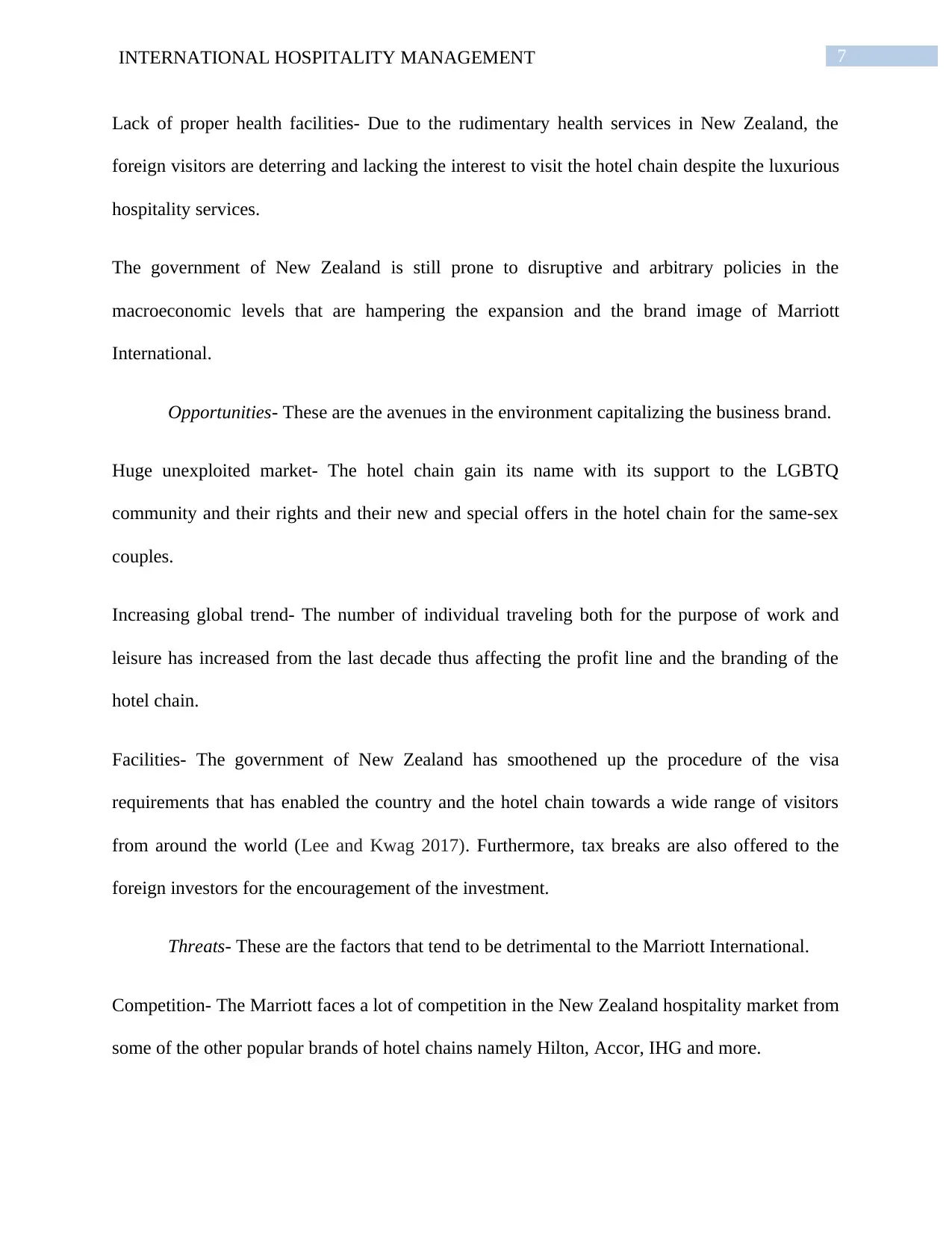
7INTERNATIONAL HOSPITALITY MANAGEMENT
Lack of proper health facilities- Due to the rudimentary health services in New Zealand, the
foreign visitors are deterring and lacking the interest to visit the hotel chain despite the luxurious
hospitality services.
The government of New Zealand is still prone to disruptive and arbitrary policies in the
macroeconomic levels that are hampering the expansion and the brand image of Marriott
International.
Opportunities- These are the avenues in the environment capitalizing the business brand.
Huge unexploited market- The hotel chain gain its name with its support to the LGBTQ
community and their rights and their new and special offers in the hotel chain for the same-sex
couples.
Increasing global trend- The number of individual traveling both for the purpose of work and
leisure has increased from the last decade thus affecting the profit line and the branding of the
hotel chain.
Facilities- The government of New Zealand has smoothened up the procedure of the visa
requirements that has enabled the country and the hotel chain towards a wide range of visitors
from around the world (Lee and Kwag 2017). Furthermore, tax breaks are also offered to the
foreign investors for the encouragement of the investment.
Threats- These are the factors that tend to be detrimental to the Marriott International.
Competition- The Marriott faces a lot of competition in the New Zealand hospitality market from
some of the other popular brands of hotel chains namely Hilton, Accor, IHG and more.
Lack of proper health facilities- Due to the rudimentary health services in New Zealand, the
foreign visitors are deterring and lacking the interest to visit the hotel chain despite the luxurious
hospitality services.
The government of New Zealand is still prone to disruptive and arbitrary policies in the
macroeconomic levels that are hampering the expansion and the brand image of Marriott
International.
Opportunities- These are the avenues in the environment capitalizing the business brand.
Huge unexploited market- The hotel chain gain its name with its support to the LGBTQ
community and their rights and their new and special offers in the hotel chain for the same-sex
couples.
Increasing global trend- The number of individual traveling both for the purpose of work and
leisure has increased from the last decade thus affecting the profit line and the branding of the
hotel chain.
Facilities- The government of New Zealand has smoothened up the procedure of the visa
requirements that has enabled the country and the hotel chain towards a wide range of visitors
from around the world (Lee and Kwag 2017). Furthermore, tax breaks are also offered to the
foreign investors for the encouragement of the investment.
Threats- These are the factors that tend to be detrimental to the Marriott International.
Competition- The Marriott faces a lot of competition in the New Zealand hospitality market from
some of the other popular brands of hotel chains namely Hilton, Accor, IHG and more.
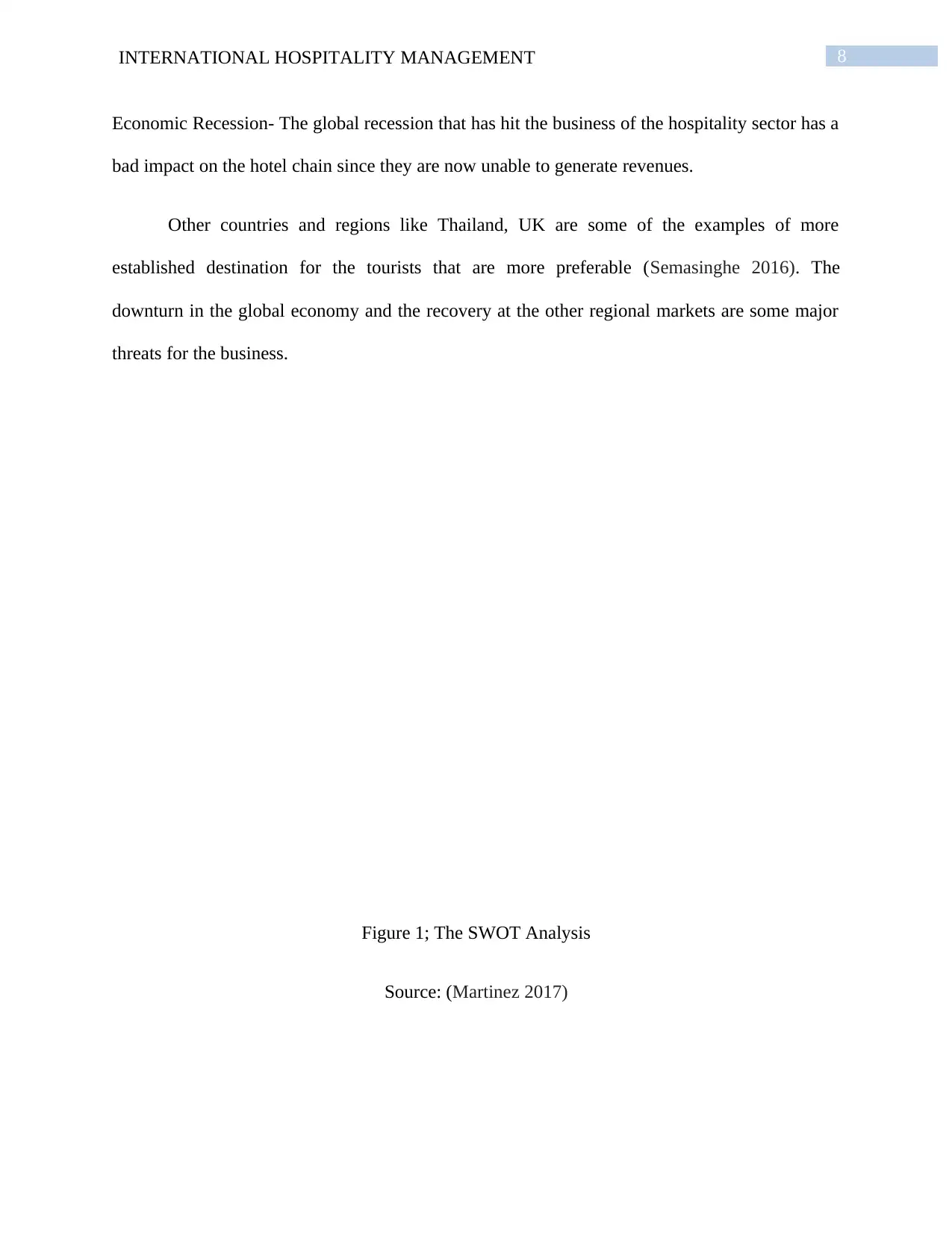
8INTERNATIONAL HOSPITALITY MANAGEMENT
Economic Recession- The global recession that has hit the business of the hospitality sector has a
bad impact on the hotel chain since they are now unable to generate revenues.
Other countries and regions like Thailand, UK are some of the examples of more
established destination for the tourists that are more preferable (Semasinghe 2016). The
downturn in the global economy and the recovery at the other regional markets are some major
threats for the business.
Figure 1; The SWOT Analysis
Source: (Martinez 2017)
OppertunitiesHugeunexploitedmarketIncreasingglobaThreatsCompetitionEconomicRecessionPrefeSWOTAnalysis
Economic Recession- The global recession that has hit the business of the hospitality sector has a
bad impact on the hotel chain since they are now unable to generate revenues.
Other countries and regions like Thailand, UK are some of the examples of more
established destination for the tourists that are more preferable (Semasinghe 2016). The
downturn in the global economy and the recovery at the other regional markets are some major
threats for the business.
Figure 1; The SWOT Analysis
Source: (Martinez 2017)
OppertunitiesHugeunexploitedmarketIncreasingglobaThreatsCompetitionEconomicRecessionPrefeSWOTAnalysis
⊘ This is a preview!⊘
Do you want full access?
Subscribe today to unlock all pages.

Trusted by 1+ million students worldwide
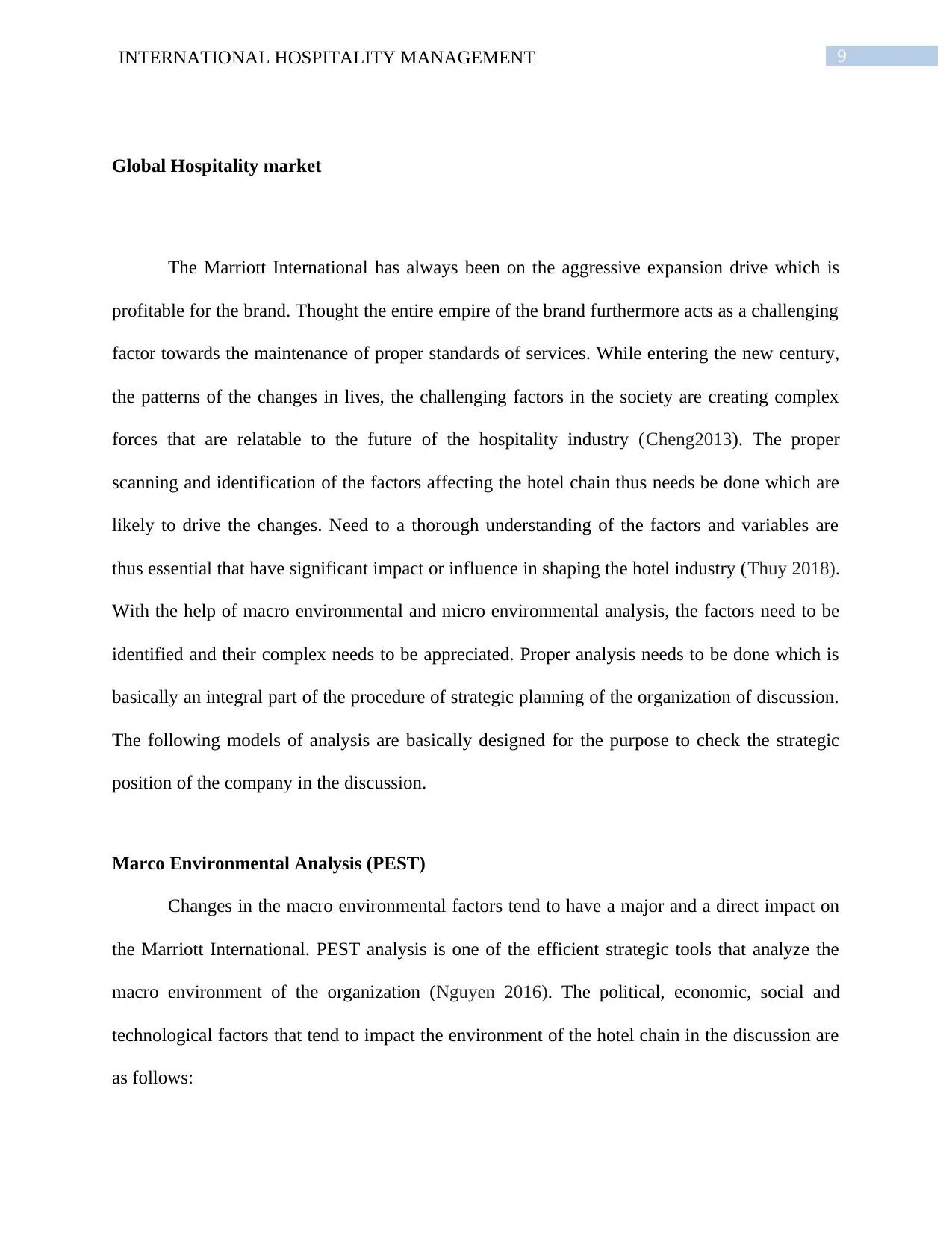
9INTERNATIONAL HOSPITALITY MANAGEMENT
Global Hospitality market
The Marriott International has always been on the aggressive expansion drive which is
profitable for the brand. Thought the entire empire of the brand furthermore acts as a challenging
factor towards the maintenance of proper standards of services. While entering the new century,
the patterns of the changes in lives, the challenging factors in the society are creating complex
forces that are relatable to the future of the hospitality industry (Cheng2013). The proper
scanning and identification of the factors affecting the hotel chain thus needs be done which are
likely to drive the changes. Need to a thorough understanding of the factors and variables are
thus essential that have significant impact or influence in shaping the hotel industry (Thuy 2018).
With the help of macro environmental and micro environmental analysis, the factors need to be
identified and their complex needs to be appreciated. Proper analysis needs to be done which is
basically an integral part of the procedure of strategic planning of the organization of discussion.
The following models of analysis are basically designed for the purpose to check the strategic
position of the company in the discussion.
Marco Environmental Analysis (PEST)
Changes in the macro environmental factors tend to have a major and a direct impact on
the Marriott International. PEST analysis is one of the efficient strategic tools that analyze the
macro environment of the organization (Nguyen 2016). The political, economic, social and
technological factors that tend to impact the environment of the hotel chain in the discussion are
as follows:
Global Hospitality market
The Marriott International has always been on the aggressive expansion drive which is
profitable for the brand. Thought the entire empire of the brand furthermore acts as a challenging
factor towards the maintenance of proper standards of services. While entering the new century,
the patterns of the changes in lives, the challenging factors in the society are creating complex
forces that are relatable to the future of the hospitality industry (Cheng2013). The proper
scanning and identification of the factors affecting the hotel chain thus needs be done which are
likely to drive the changes. Need to a thorough understanding of the factors and variables are
thus essential that have significant impact or influence in shaping the hotel industry (Thuy 2018).
With the help of macro environmental and micro environmental analysis, the factors need to be
identified and their complex needs to be appreciated. Proper analysis needs to be done which is
basically an integral part of the procedure of strategic planning of the organization of discussion.
The following models of analysis are basically designed for the purpose to check the strategic
position of the company in the discussion.
Marco Environmental Analysis (PEST)
Changes in the macro environmental factors tend to have a major and a direct impact on
the Marriott International. PEST analysis is one of the efficient strategic tools that analyze the
macro environment of the organization (Nguyen 2016). The political, economic, social and
technological factors that tend to impact the environment of the hotel chain in the discussion are
as follows:
Paraphrase This Document
Need a fresh take? Get an instant paraphrase of this document with our AI Paraphraser
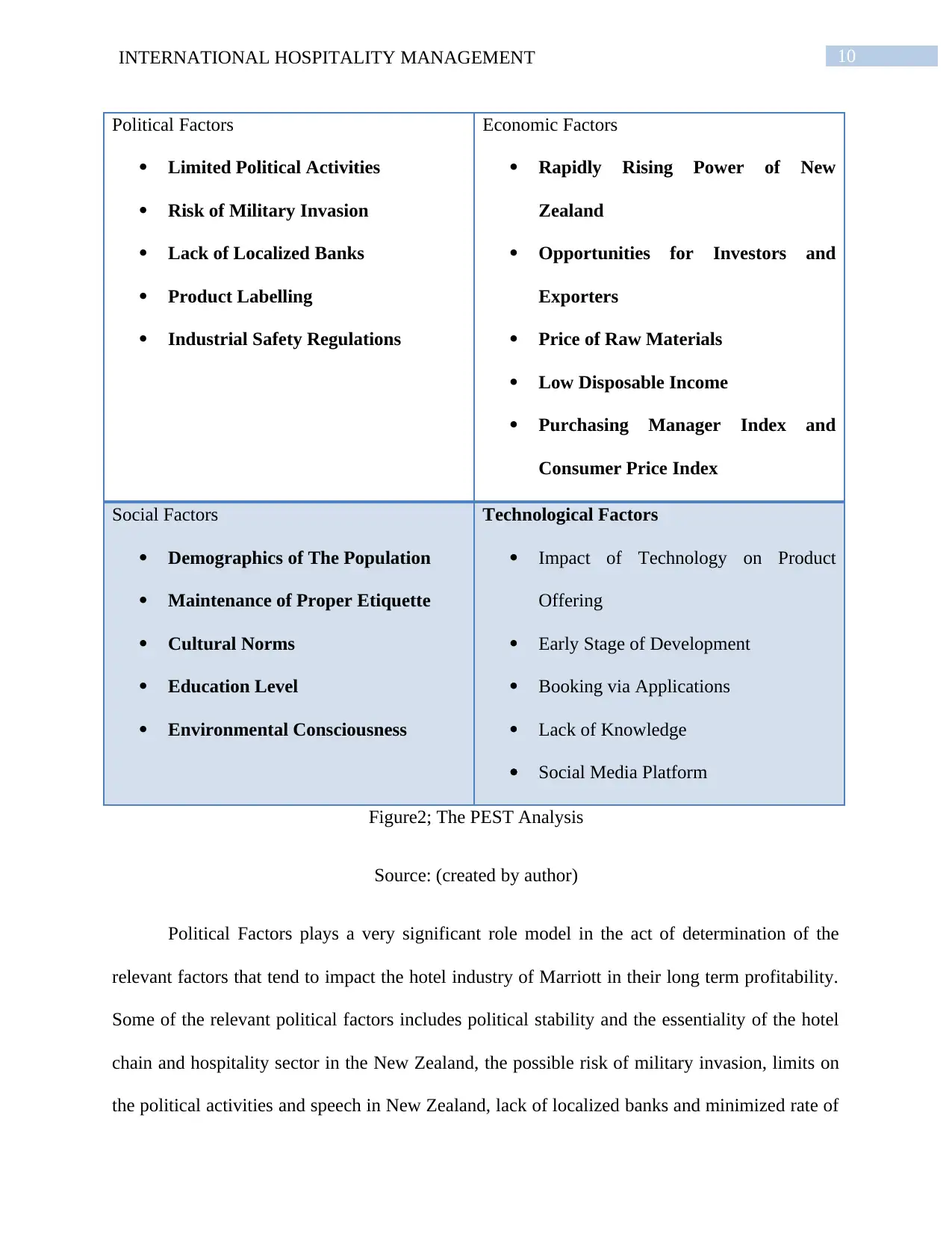
10INTERNATIONAL HOSPITALITY MANAGEMENT
Political Factors
Limited Political Activities
Risk of Military Invasion
Lack of Localized Banks
Product Labelling
Industrial Safety Regulations
Economic Factors
Rapidly Rising Power of New
Zealand
Opportunities for Investors and
Exporters
Price of Raw Materials
Low Disposable Income
Purchasing Manager Index and
Consumer Price Index
Social Factors
Demographics of The Population
Maintenance of Proper Etiquette
Cultural Norms
Education Level
Environmental Consciousness
Technological Factors
Impact of Technology on Product
Offering
Early Stage of Development
Booking via Applications
Lack of Knowledge
Social Media Platform
Figure2; The PEST Analysis
Source: (created by author)
Political Factors plays a very significant role model in the act of determination of the
relevant factors that tend to impact the hotel industry of Marriott in their long term profitability.
Some of the relevant political factors includes political stability and the essentiality of the hotel
chain and hospitality sector in the New Zealand, the possible risk of military invasion, limits on
the political activities and speech in New Zealand, lack of localized banks and minimized rate of
Political Factors
Limited Political Activities
Risk of Military Invasion
Lack of Localized Banks
Product Labelling
Industrial Safety Regulations
Economic Factors
Rapidly Rising Power of New
Zealand
Opportunities for Investors and
Exporters
Price of Raw Materials
Low Disposable Income
Purchasing Manager Index and
Consumer Price Index
Social Factors
Demographics of The Population
Maintenance of Proper Etiquette
Cultural Norms
Education Level
Environmental Consciousness
Technological Factors
Impact of Technology on Product
Offering
Early Stage of Development
Booking via Applications
Lack of Knowledge
Social Media Platform
Figure2; The PEST Analysis
Source: (created by author)
Political Factors plays a very significant role model in the act of determination of the
relevant factors that tend to impact the hotel industry of Marriott in their long term profitability.
Some of the relevant political factors includes political stability and the essentiality of the hotel
chain and hospitality sector in the New Zealand, the possible risk of military invasion, limits on
the political activities and speech in New Zealand, lack of localized banks and minimized rate of
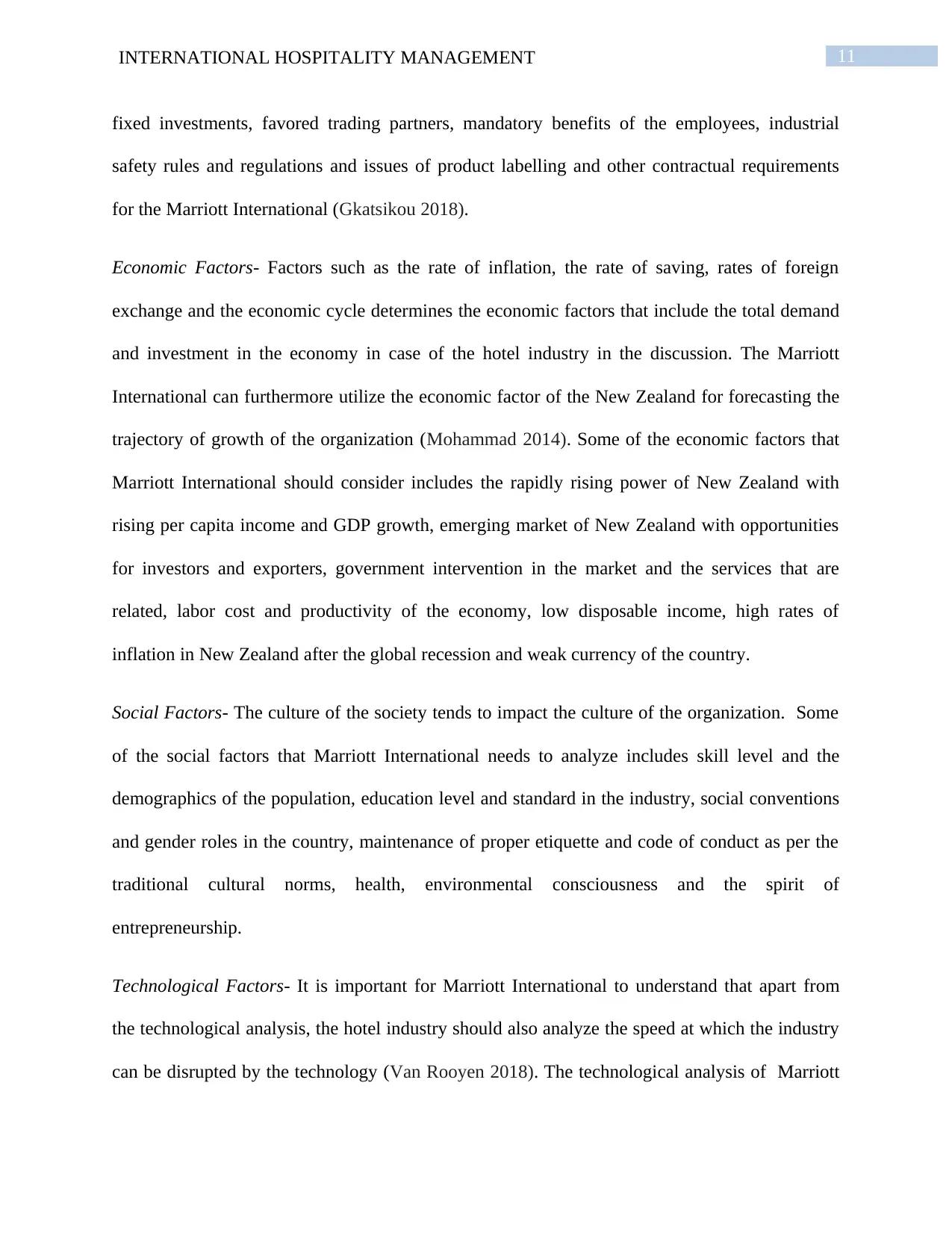
11INTERNATIONAL HOSPITALITY MANAGEMENT
fixed investments, favored trading partners, mandatory benefits of the employees, industrial
safety rules and regulations and issues of product labelling and other contractual requirements
for the Marriott International (Gkatsikou 2018).
Economic Factors- Factors such as the rate of inflation, the rate of saving, rates of foreign
exchange and the economic cycle determines the economic factors that include the total demand
and investment in the economy in case of the hotel industry in the discussion. The Marriott
International can furthermore utilize the economic factor of the New Zealand for forecasting the
trajectory of growth of the organization (Mohammad 2014). Some of the economic factors that
Marriott International should consider includes the rapidly rising power of New Zealand with
rising per capita income and GDP growth, emerging market of New Zealand with opportunities
for investors and exporters, government intervention in the market and the services that are
related, labor cost and productivity of the economy, low disposable income, high rates of
inflation in New Zealand after the global recession and weak currency of the country.
Social Factors- The culture of the society tends to impact the culture of the organization. Some
of the social factors that Marriott International needs to analyze includes skill level and the
demographics of the population, education level and standard in the industry, social conventions
and gender roles in the country, maintenance of proper etiquette and code of conduct as per the
traditional cultural norms, health, environmental consciousness and the spirit of
entrepreneurship.
Technological Factors- It is important for Marriott International to understand that apart from
the technological analysis, the hotel industry should also analyze the speed at which the industry
can be disrupted by the technology (Van Rooyen 2018). The technological analysis of Marriott
fixed investments, favored trading partners, mandatory benefits of the employees, industrial
safety rules and regulations and issues of product labelling and other contractual requirements
for the Marriott International (Gkatsikou 2018).
Economic Factors- Factors such as the rate of inflation, the rate of saving, rates of foreign
exchange and the economic cycle determines the economic factors that include the total demand
and investment in the economy in case of the hotel industry in the discussion. The Marriott
International can furthermore utilize the economic factor of the New Zealand for forecasting the
trajectory of growth of the organization (Mohammad 2014). Some of the economic factors that
Marriott International should consider includes the rapidly rising power of New Zealand with
rising per capita income and GDP growth, emerging market of New Zealand with opportunities
for investors and exporters, government intervention in the market and the services that are
related, labor cost and productivity of the economy, low disposable income, high rates of
inflation in New Zealand after the global recession and weak currency of the country.
Social Factors- The culture of the society tends to impact the culture of the organization. Some
of the social factors that Marriott International needs to analyze includes skill level and the
demographics of the population, education level and standard in the industry, social conventions
and gender roles in the country, maintenance of proper etiquette and code of conduct as per the
traditional cultural norms, health, environmental consciousness and the spirit of
entrepreneurship.
Technological Factors- It is important for Marriott International to understand that apart from
the technological analysis, the hotel industry should also analyze the speed at which the industry
can be disrupted by the technology (Van Rooyen 2018). The technological analysis of Marriott
⊘ This is a preview!⊘
Do you want full access?
Subscribe today to unlock all pages.

Trusted by 1+ million students worldwide
1 out of 32
Related Documents
Your All-in-One AI-Powered Toolkit for Academic Success.
+13062052269
info@desklib.com
Available 24*7 on WhatsApp / Email
![[object Object]](/_next/static/media/star-bottom.7253800d.svg)
Unlock your academic potential
Copyright © 2020–2025 A2Z Services. All Rights Reserved. Developed and managed by ZUCOL.





